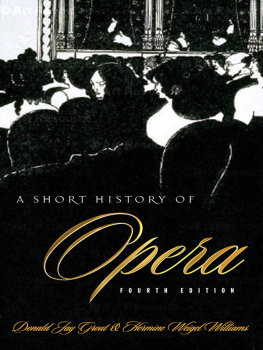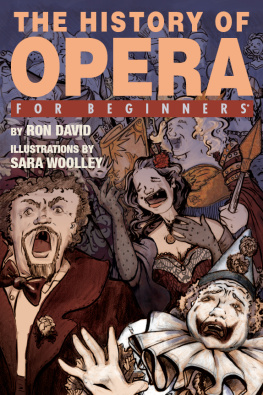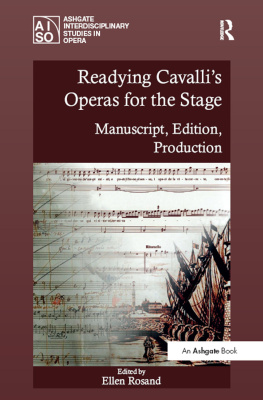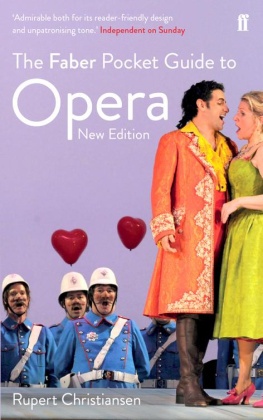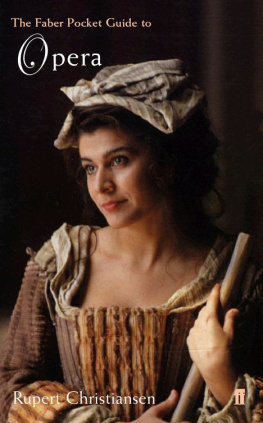CONTENTS
A BOUT THE BOOK
Kobbs Opera Book is the worlds leading reference work on opera, and (in the words of Bernard Levin) no single-volume operatic guide can possibly compare with it. Kobb is the only book which summarises the libretti of the worlds operas, describes their music and gives a history of their performance within a single volume. First published in 1922, it is now in its 10th edition. All the essential information is included on well over 200 operas - all those currently in the repertoire of the worlds leading opera companies, as well as many that are more rarely performed. The work of editing and condensing has been carried out by the Earl of Harewood, who has been editor of Kobb for more than thirty years, assisted by Michael Shmith, Arts Editor of the MELBOURNE AGE and a leading opera authority.
E DITORS NOTE
THE NEW POCKET KOBBS OPERA BOOK is much enlarged and substantially re-thought. To begin with, it is more comprehensive, covering nearly 270 titles as compared with a mere 200, but it retains the essential claim of its title: a pocket doesnt have to be outsize to hold it.
Secondly, it now follows the example of the parent volume and composers are found in alphabetical order (with operas appearing in chronological order of composition), which makes each individual opera quite a lot easier to find. As before, a comprehensive index of composers and titles is included. Again following the parent volume, it has been decided to transliterate Mussorgskys name thus instead of Moussorgsky as in the first edition.
Once again, the editors have not attempted to be entirely consistent in the use of role names but have aimed at what seems most natural to an English speaker. Electra is found in Strauss as well as Mozart, but Orfeo in Monteverdi and Orpheus in Gluck if for no other reason than that Glucks most famous opera comes in both Italian and French versions.
Translations of opera titles have usually been given, unless the meanings are either obvious (Tristan und Isolde) or virtually untranslatable (Cos fan tutte). In the case of Russian, Czech, Hungarian and Polish operas, the reference is usually under the English title with the original language given beneath, but there are exceptions when the original (Khovanshchina) is so well known that it seems pedantic to lead with the lesser-known English.
For reasons of space always a consideration here the plots of some more rarely performed operas are summarised in a brief outline rather than the more discursive treatment which has from the very start been a mark of the Kobb style.
H.
M.S.
A
J OHN A DAMS
(b. 1947)
N IXON IN C HINA
O PERA in three acts; libretto by Alice Goodman. Premire, Houston, October 22, 1987.
BORN TEN YEARS after Philip Glass and described by Alice Goodman as a minimalist bored with minimalism, John Adams is nonetheless regularly grouped with Steve Reich and Philip Glass. It was Peter Sellars, because he prefers to work on a new opera rather than one that already exists, who came up with Nixon in China as an operatic subject. The three collaborators agreed from the start that this was to be a heroic opera and in no sense a satire. Its strength they believed would come from the extreme familiarity all over the world of characters such as the Nixons and Henry Kissinger, and the fame of Mao Tse-Tung, his wife and Chou En-Lai. The time is February 1972.
ACT I . Beijing. Rising scales open the opera and continue as Chinese soldiers, waiting for the arrival of the American President (baritone), engage in slow, repetitive patriotic singing. Tension grows to the moment when the Presidential plane (The Spirit of 76) comes to a stop. Nixons aria, News has a kind of mystery (the word news reiterated twelve times), is neo-classical in style, and during its course Chou (baritone) attempts to introduce various civic worthies while Nixon goes into ecstasy over the idea that the eyes and ears of Hissstory are taking note of their actions.
Scene ii. Chairman Maos (tenor) study, where he receives President Nixon. His three secretaries (sopranos and contralto) echo Maos words and the ensemble bubbles along, with Mao dispensing philosophical apophthegms, and gnomic jokes. Nixon falls back on diplomatic fencing, and Kissinger (bass-baritone), cast throughout as a kind of villain, is constantly, as he himself admits, out of his depth. Suddenly Mao has a brainwave: Founders come first, then profiteers, and this will return to him every now and then until the end of the scene. Nixon finally attempts to seize the initiative. Mao is left to his books and his dictation: Founders come
Scene iii. A banquet is being held in the Great Hall of the People. The atmosphere is at first more relaxed and Nixon and Pat (soprano) exchange a few words at the start. Gentle verbal fencing between the principals precedes a toast Gambei before Premier Chous speech, which is assured and yet subtle. Nixon seems at first nervous but confidence grows as he speaks, until he reaches a purple climax and enthusiasm takes over. Nixon plays a trump card:
Nixon: Everyone
Listen, just let me say one thing
I opposed China. I was wrong.
The act ends in an orgy of toasts.
ACT II . Scene i. It is the morning of the second day Mrs. Nixons turn to meet China. She is taken to a glass factory, a clinic and a pig farm, she meets crowds of children and finishes with a visit to the Ming Tombs. The action occurs in the interludes of an extended scena and aria.
Scene ii. Together with Madam Mao (Chiang Ching; high soprano) and Premier Chou, the Nixons are to see a ballet performance, The Red Detachment of Women, a revolutionary farrago devised in real life (for the cultural revolution in 1966) by Chiang Ching. Her aim was to remove western cultural influences and to replace them with scenarios of political significance. The trouble is that the music written specially for them (probably, as John Adams once suggested, by a committee) had distinct overtones of the nineteenth-century Russian ballets they so despised.
From the outset the atmosphere for the ballet is one of expectancy. It is a bizarre affair. Young women are chained to posts on an estate and Lao Szu, the landlords factotum (played by the singer of Kissinger), has one of them, Ching Hua, beaten into insensibility. Pat Nixon cannot bear the stage action and intervenes. The Peoples Army takes over and Ching Hua is presented with a rifle. Ching Hua attempts rebellion. This is the cue for Chiang Ching to start an aria and somehow bring the action to an end.
The music is ostinato-based and frequently builds a considerable head of rhythmic steam. Chiang Chings aria I am the wife of Mao Tse-Tung is an extended solo, studded with top B flats, Cs and the occasional D, and the musics relentless nature mirrors that of the character.
ACT III . It is the last night in Beijing and the elegiac music suggests we are in another world, contemplative and almost devoid of action, with the protagonists reduced to musing on present , past and future. Only Mao appears to retain a semblance of vitality, and he dances with his wife and reminisces of their first meeting and campaigning together. Chiang Ching takes to wordless coloratura, Chou is the most cogently philosophical, Mao content to babble, Nixon to talk aimlessly of the war and risks perceived but not quite confronted, Pat to react to what her husband says. Often the composer, while writing lyrical music of considerable beauty, seems unconcerned to make the words audible, but we hear clearly Nixons claim to have won at poker and what he says became his political motto, Speak softly and dont show your hand. Whatever we miss, we hear Chous summing up of his own outlook and of the memorable five days:




